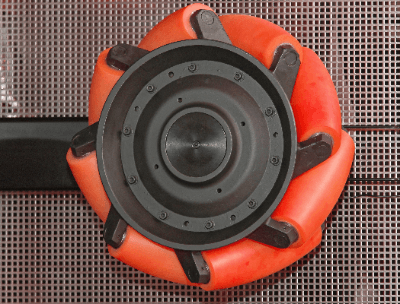What Is an Omni Wheel?
 An Omni wheel is a wheel that can move in any direction. It consists of a main rotating part on the body and a passive rotating part of rollers placed on the outer circle of the body.
An Omni wheel is a wheel that can move in any direction. It consists of a main rotating part on the body and a passive rotating part of rollers placed on the outer circle of the body.
Usually, a set of three wheels or a set of four wheels is used. Compared to a wheel configuration with tires using a steering wheel, such as in an automobile, the moving mechanism is simpler, making it suitable for smaller sizes and lighter weight.
Uses of Omni Wheels
Omni wheels are mainly used as moving mechanisms for robots and carts. Because they are suitable for moving in confined spaces, they are often used as an unmanned transport robot in factories and warehouses, or as a wheelchair for indoor environments such as hospitals.
Omni wheels as an unmanned transport robot also include a robot with a human tracking function equipped with sensors. Since the Omni wheels can move with work equipment on them, they can be used as both a dolly and a work platform.
Principle of Omni Wheels
The Omni wheel is a wheel that transmits the driving force of a motor in the vertical direction and rotates in the horizontal direction by a free mechanism that has no self-driving force. Turning and parallel movement in all directions is made possible by adjusting the speed control of each motor relative to the omniwheel’s grip on the road surface.
Usually, one set of three wheels or one set of four wheels is used. The characteristics of each are shown below.
1. 3-Wheel Configuration
Compared to a 4-wheel configuration, the 3-wheel configuration has the advantage of being smaller and lighter because it has one less drive system. However, since the amount of movement in any direction is the combined force of vectors, the straightness of the vehicle may deteriorate depending on the road surface.
2. 4-Wheel Configuration
In the case of a 4-wheel configuration, movement in the front-back and left-right directions is the same as that of a normal tire like a car, so high straight-line performance can be expected. On the other hand, it has the disadvantage of being larger and heavier as a whole because it has one more drive system than the 3-wheel configuration.
Features of Omni Wheels
Advantages
- They are capable of turning on the spot and parallel movement in all directions.
- The drive system can be configured with a minimum of three wheels, simplifying the movement mechanism and reducing size and weight compared to a four-wheel-drive system.
- Less vibration during operation
In particular, there is a big difference in mobile robots: a two-wheeled robot “basically moves forward while changing its direction of movement toward the target,” while an omni wheeled robot “moves parallel to the target with its direction of movement fixed at all times.”
This means that the omni wheels eliminate the procedure of “changing direction before moving,” which is a big advantage of “quick movement in the shortest distance.
Because the Omni wheels have such a big advantage in quick movement, many robots for robot contests, in which contestants compete in terms of time to reach the goal, are equipped with a movement mechanism that uses the Omni wheels.
There is no fixed component structure for omni wheels, and there are a variety of materials, angles, and numbers of rollers placed on the passive rotating parts. Since each omni wheel has its own special environment, application, load capacity, etc., it is necessary to select one that best suits the intended use.
Disadvantages
Disadvantages of omni wheels include: “weak against bumps” and “weak for outdoor use.” This is due to the operating principle of the omni wheel, and both conditions are caused by the issue of insufficient grip on the ground.
Other Information About the Omni Wheels
1. How to Control an Omni Wheel Robot
In the case of the 4-wheel type, four omni wheels are mounted every 90 degrees to the machine base. A motor is attached to each omniwheel. The speed and direction of the platform are determined by issuing commands to the motors independently.
For example, if the platform is to move straight ahead in the X direction, it must be controlled so that the sum of the velocity vectors of each Omni wheel in the Y direction becomes zero.
2. Points to Note in Control
One point to note in control is that insufficient grip on the ground will cause tire slippage. If even one of the omni wheels idles, the sum of the velocity vectors of the omni wheels will deviate from the expected value. A mechanism is needed to correct the motor commands each time by incorporating feedback control or other means.
Feedback control refers to control in which the output control quantity is fed back to the input value and the input value is corrected so that the difference between the output and input is zero. This control is capable of making corrections even when disturbances such as idling occur.